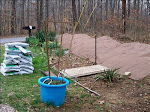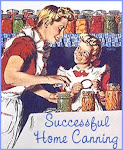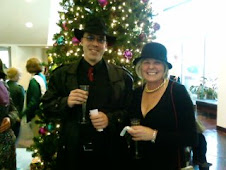 Planted: Mammoth Dill, Mammoth Sunflowers. Black Magic elephant ears, hostas and ferns in a shaded bed by the front door. Wisteria along the fence.
Planted: Mammoth Dill, Mammoth Sunflowers. Black Magic elephant ears, hostas and ferns in a shaded bed by the front door. Wisteria along the fence.Harvested: Sugar Snap peas, chives, rosemary, basil for pesto
Prepped: Enlarged vegetable beds along the deck. Time to order more compost.
Managed: Added a soupcon of hot compost to the sides of the tomato plant. Weeded flower beds. Laid cardboard for paths then covered with shredded bark mulch. Shredded more white paper for use in compost #1 (the rawest compost).
Ordered these books:
Food Drying Techniques : Carol W. Costenbader
Making Cheese, Butter & Yogurt : Ricki Carroll
Making Natural Milk Soap : Casey Makela
Food Drying Techniques : Carol W. Costenbader
Making Cheese, Butter & Yogurt : Ricki Carroll
Making Natural Milk Soap : Casey Makela

Tomato Plants
When I was researching the types of flowers to plant that would attract bees, I found out some interesting info about how flowers look to bees and birds. The ultraviolet rays form a bulls-eye pattern on the flower that not only attracts bees but warns caterpillars not to feed on certain plants. This link shows you photos of the flower in natural light and also in UV light.
http://www.naturfotograf.com/UV_flowers_list.html
This is an article about flower chemicals
http://www.sciencedaily.com/releases/2001/11/011120044731.htm
http://www.naturfotograf.com/UV_flowers_list.html
This is an article about flower chemicals
http://www.sciencedaily.com/releases/2001/11/011120044731.htm
- Local: Hooked up with the local Beekeepers group, found a local source for fresh eggs, bought local farmer’s market peaches. I left messages with two local tree companies asking them to bring dump materials (tree trunks, branches, bark and sawdust) to my house. I heard from somebody in the biz that they’ll do that. ~~~~~~~~~~~~~~~~~~~~~~~~~~~~~~~~~~~~~~~~~~~~~~~~~~~~~~~~~~~~~~~~~
The Notebooks
The Food Independence Days Challenge is an online class about food storage and self sufficiency. Certainly I’ve learned as much in the last eight weeks as I did in eight weeks of college. As I would with any course, I put together a notebook with suggestions and information about the topic. As I read and researched, I realized that I wanted to preserve some of the best info and pictures for future use, so I did step-by-step instructions with photographs for each of the following topics:
Bees (still working on this one)
Bread -How to make bread
Candles - How to make candles
Canning Guide - Complete USDA guide
Chickens -How to find where your hen lays eggs, keep a clean henhouse, Henhouse designs Dairy - Cheesemaking instructions with how-to photos
How to milk a goat w/ photos
How to pour off cream and make butter w/ photos
(Looking for actual photos of milking a cow)
Gardening Guides
How to compost
How to take care of fruit trees
How to make your own gardening tonics
How to care for house plants
Vegetable gardening
Different gardening methods with drawings and illustrations
Tips
Herbs
Herbal remedies
Buying Bulk herbs
Mushrooms
How to grow mushrooms on a log
Pictures
How to harvest
How to store
Soap
How to make
Solar
How to make a solar generator
How to make a solar dehydrator
Using mirrors to enhance panel performance
Sprouts
Different methods of growing
Storing
Water
How to rig your own rain catch system
How to make a purifier
Water storage guidelines including purification
Fun Stuff:
Beer for Compost
Compost pile #3 is about ready to filter and use. A couple of weeks ago I decided to give compost pile #2’s decomposition process a boost by adding ½ a bottle of beer to the several bushels of composting materials. The beer adds bacteria which speed up the process. It also makes the compost heap smell like what it is—a pile of rot. My neighbors were pretty pissed when they couldn’t use their pools for a couple of days because my compost pile smelled so bad.
Missing Umbrella
One day I had worked in the yard, cleaned everything up, put up the umbrellas including the beach umbrella we use sometimes on the deck. I went in to get Hub so he could check out the beauty, and we couldn’t find the beach umbrella anywhere. We went all over the neighborhood.
One day I had worked in the yard, cleaned everything up, put up the umbrellas including the beach umbrella we use sometimes on the deck. I went in to get Hub so he could check out the beauty, and we couldn’t find the beach umbrella anywhere. We went all over the neighborhood.
Caterpillars Love the Fennel 
Every year we grow fennel so we can watch the caterpillars feed and hang…always hoping to see one of them emerge from the cocoon. This season we’ve had three egg-laying episodes on one fennel. By accident I closely planted three important foods for all butterfly stages: sunflowers, tickseed, butterfly bush, fennel.

Every year we grow fennel so we can watch the caterpillars feed and hang…always hoping to see one of them emerge from the cocoon. This season we’ve had three egg-laying episodes on one fennel. By accident I closely planted three important foods for all butterfly stages: sunflowers, tickseed, butterfly bush, fennel.



















